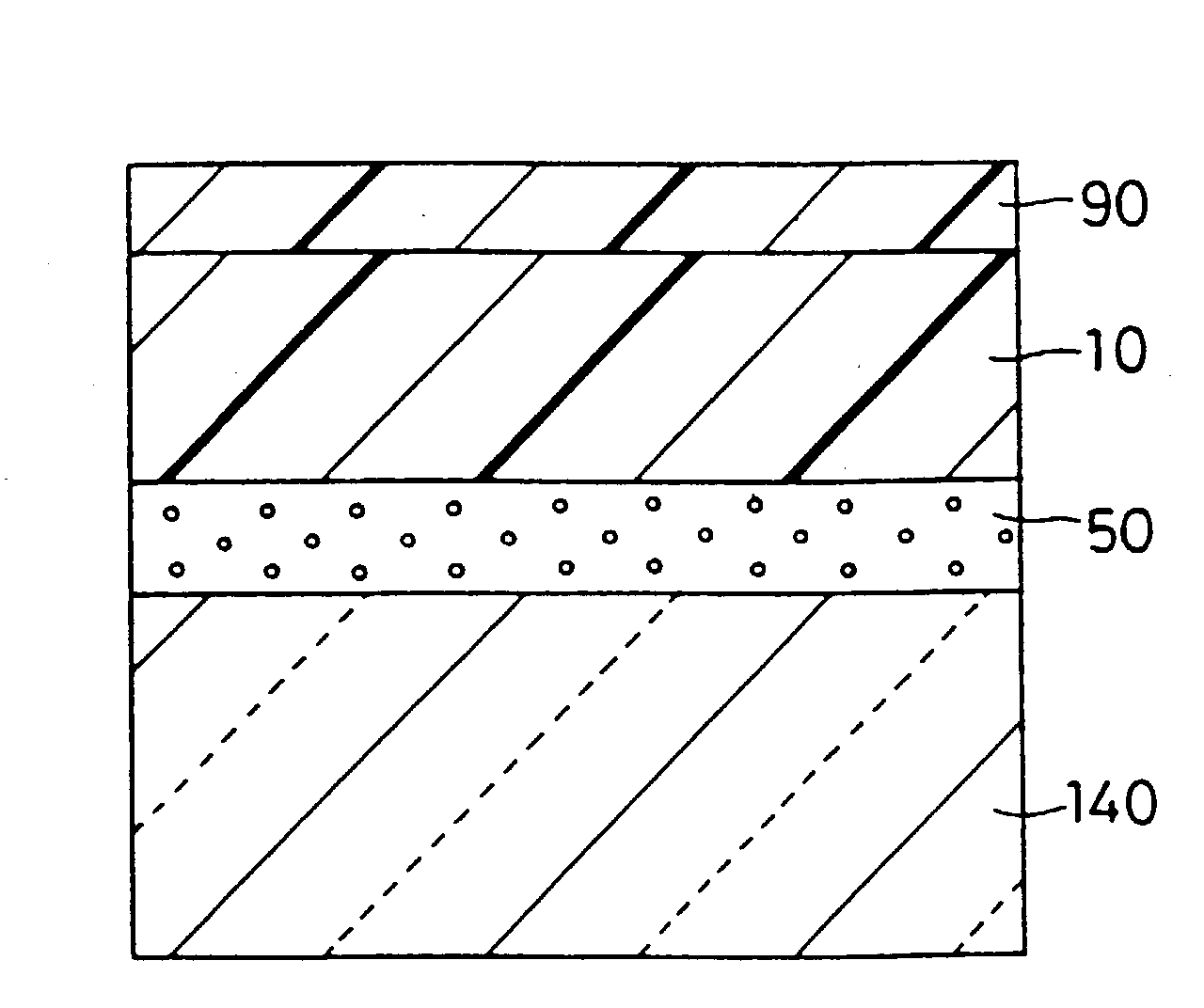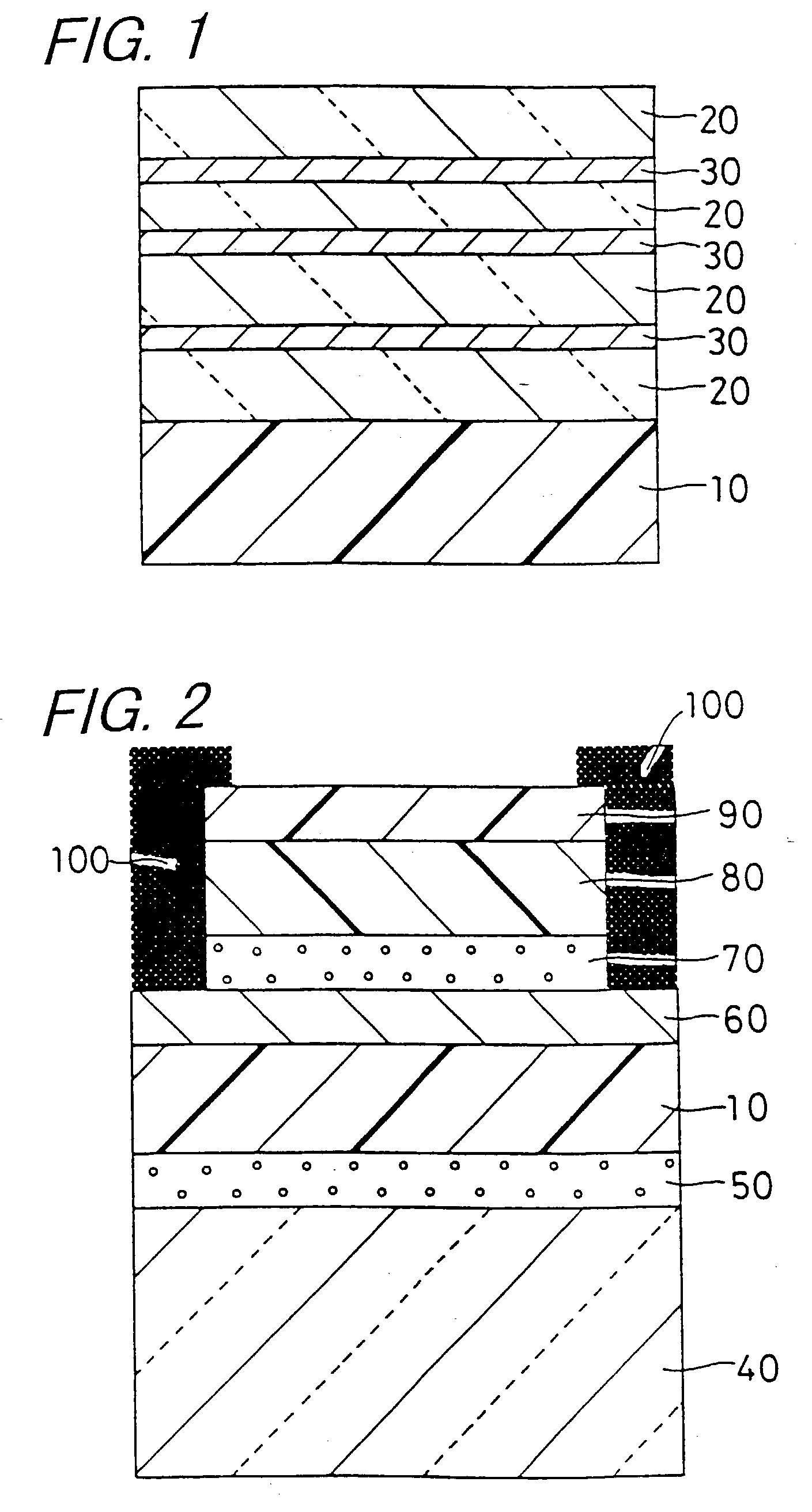Laminate body and display device using the laminated body
a technology of laminated body and display device, which is applied in the direction of weaving, synthetic resin layered products, transportation and packaging, etc., can solve the problems of glass plate becoming more prone to external impact, and breaking, so as to reduce the deterioration of dye.
- Summary
- Abstract
- Description
- Claims
- Application Information
AI Technical Summary
Benefits of technology
Problems solved by technology
Method used
Image
Examples
example 2
[0339] The same procedures as in Example 1 are repeated except that a silicone type transparent adhesive layer is prepared and used as a transparent adhesive layer characterized by elasticity.
[0340] (Preparation of Silicone Type Adhesive)
[0341] Three resins and a catalyst, as described below, are prepared.
[0342] Resin P1
[0343] A copolymer of phenyl methyl siloxane (concentration: 50 mol %), monophenyl siloxane (concentration: 15 mol %), monomethyl siloxane (concentration: 25 mol %) and diphenyl siloxane (concetration: 10 mol %); containing a zinc octate catalyst (0.6 wt %); and containing a hydroxyl group bonded to silicon.
[0344] Resin P2
[0345] A phenyl methyl vinyl siloxane copolymer comprising phenyl methyl siloxane (concentration: 60 mol %) and phenyl vinyl siloxane (concentration: 40 mol %)
[0346] Resin P3
[0347] A copolymer of phenyl methyl siloxane (50 mol %) and hydrogenated methyl siloxane (50 mol %).
[0348] Catalyst A
[0349] A xylene solution in which chloroplatinic acid (conce...
example 3
[0361] The same procedures as in Example 1 are repeated except for procedures described below.
[0362] An anti-reflection film is prepared in the same manner as in Example 1. However, a biaxially stretched polyethylene terephthalate (hereinafter referred to also as PET) film (thickness: 188 .mu.m; Young's modulus: 4,000 MPa) is used instead of triacetyl cellulose (TAC) film as a base film.
[0363] A transparent electrically conductive film is prepared on a surface reverse to a surface on which an anti-reflection layer of this anti-reflection film is formed in the same manner as in Example 1.
[0364] An acrylic adhesive (sample No. e) is prepared in the same manner as in Example 1 and, then, a dye is dispersed in the thus-prepared acrylic adhesive to form an adhesive layer.
[0365] Such a transparent adhesive layer as obtained in the above is formed on a transparent electrically conductive film of an anti-reflection film / a PET film / a transparent electrically conductive film. First of all, on...
example 4
[0374] The same procedures as in Example 1 are repeated except for the item described below.
[0375] The same procedures as in Example 3 are repeated except that the silicone type adhesive (sample No. c) used in Example 2 is used as an adhesive characterized by low elasticity.
[0376] Evaluation results are shown in Table 5.
[0377] It is demonstrated that, even when the silicone type adhesive is used as a transparent adhesive layer, a sufficient impact resistance can be obtained in the same manner as in Example 3 in which an acrylic adhesive is used.
5TABLE 5 Young's modulus (Pa) Impact resistance test Comprehensive evaluation 30,000 Passed Very good
PUM
| Property | Measurement | Unit |
|---|---|---|
| height | aaaaa | aaaaa |
| weight | aaaaa | aaaaa |
| thickness | aaaaa | aaaaa |
Abstract
Description
Claims
Application Information
 Login to View More
Login to View More - R&D
- Intellectual Property
- Life Sciences
- Materials
- Tech Scout
- Unparalleled Data Quality
- Higher Quality Content
- 60% Fewer Hallucinations
Browse by: Latest US Patents, China's latest patents, Technical Efficacy Thesaurus, Application Domain, Technology Topic, Popular Technical Reports.
© 2025 PatSnap. All rights reserved.Legal|Privacy policy|Modern Slavery Act Transparency Statement|Sitemap|About US| Contact US: help@patsnap.com



